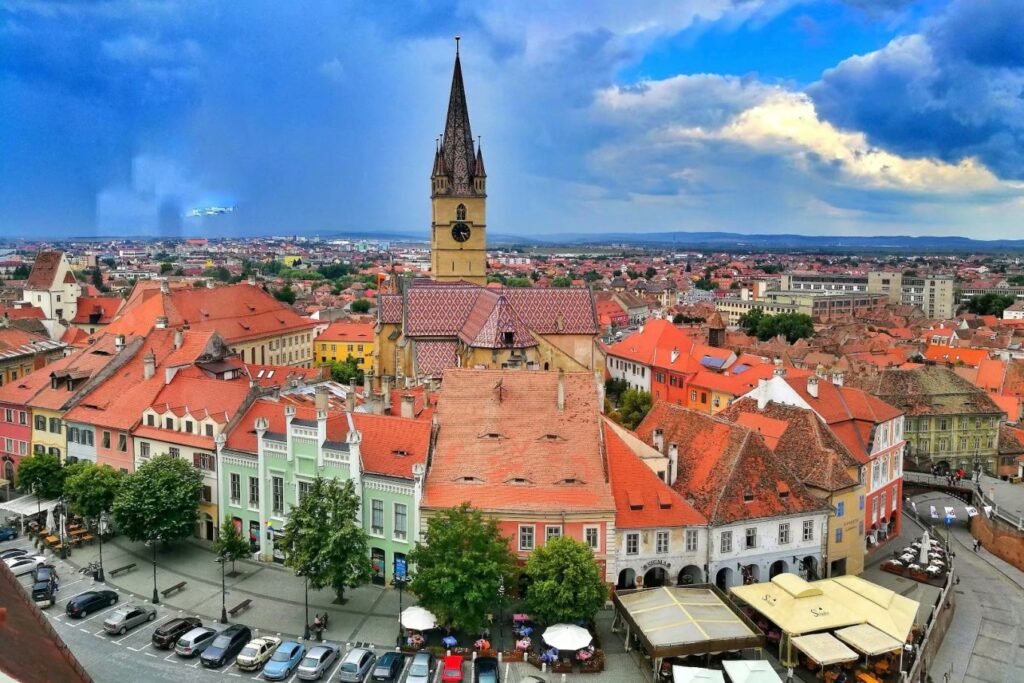Râșnov
Râșnov is a small town with a population of less than 20,000, but its impressive fortress stands tall, visible from afar with its red roofs and thick walls perched atop the mountain. On the hill where the castle sits, there’s also a giant sign spelling out “RASNOV” in white letters, modeled after Hollywood’s famous landmark.
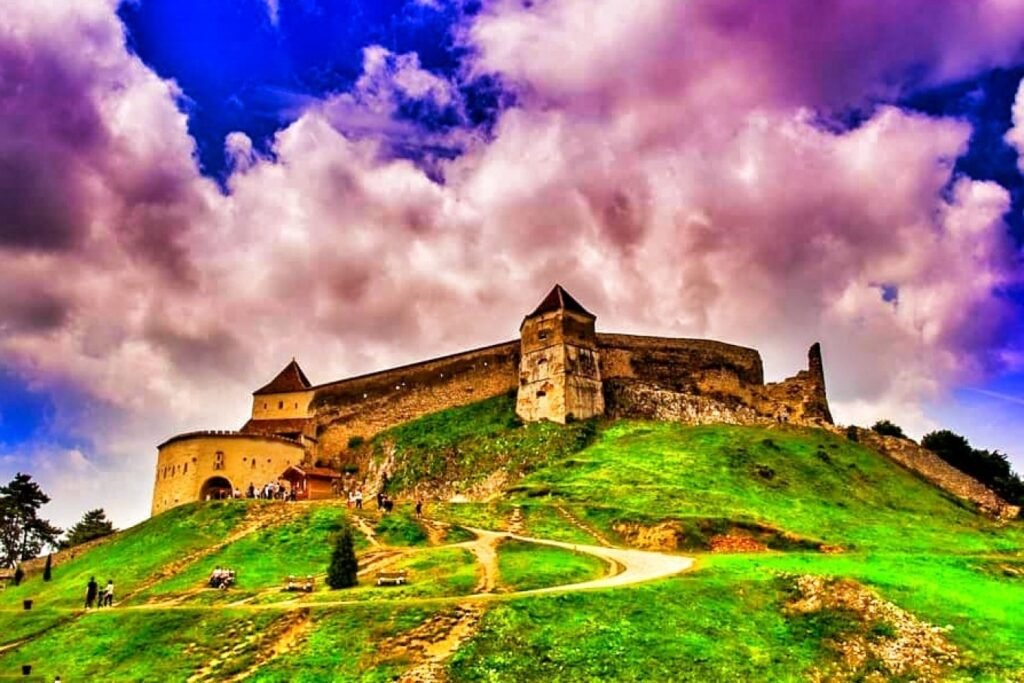
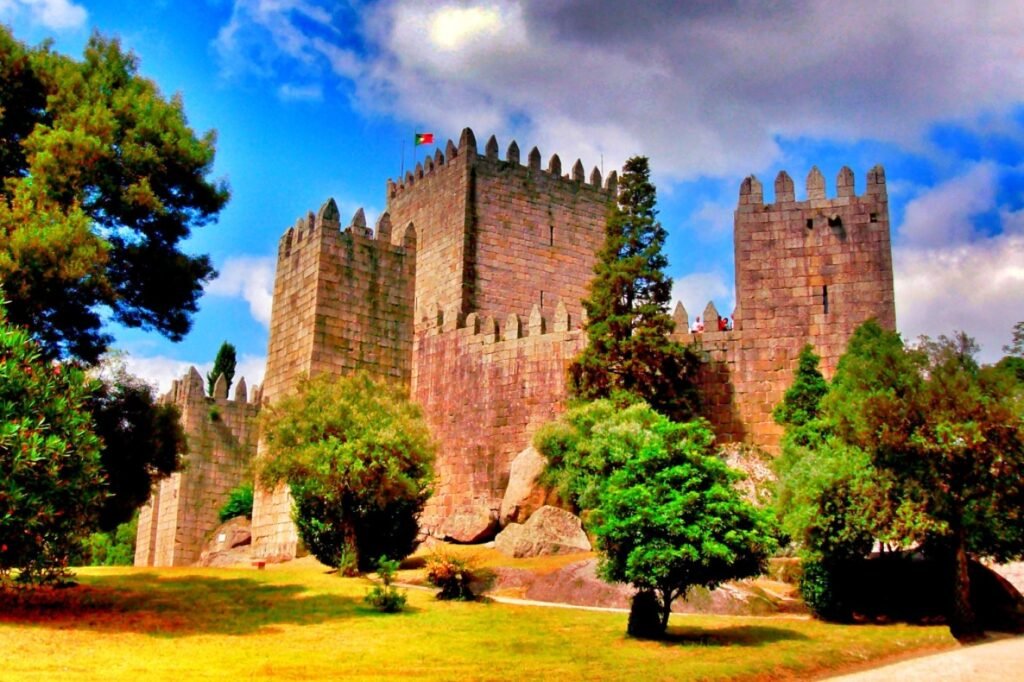
The castle, now abandoned, once served as a crucial medieval defensive structure. It still preserves 14th-century architectural remnants, along with parts of wooden fortifications left by the Teutonic Knights. Visitors can take a round-trip ride to the top using a vintage-style funicular for 12 RON, or, for those feeling adventurous, climb the stairs to the summit. The hike offers spectacular views along the way, rewarding travelers with stunning scenery.
However, the most breathtaking view awaits at the top of the fortress. Although the interior is currently closed to visitors, standing at the summit allows you to take in the magnificent panorama of Transylvania, experiencing the exhilaration of seeing the vast landscape stretch endlessly below.
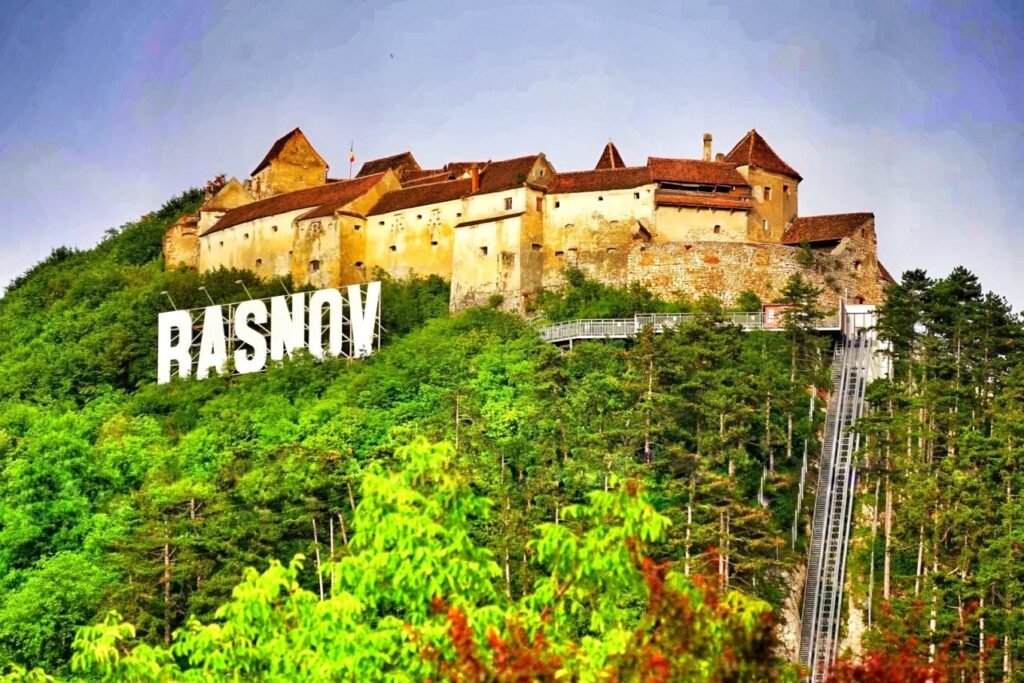
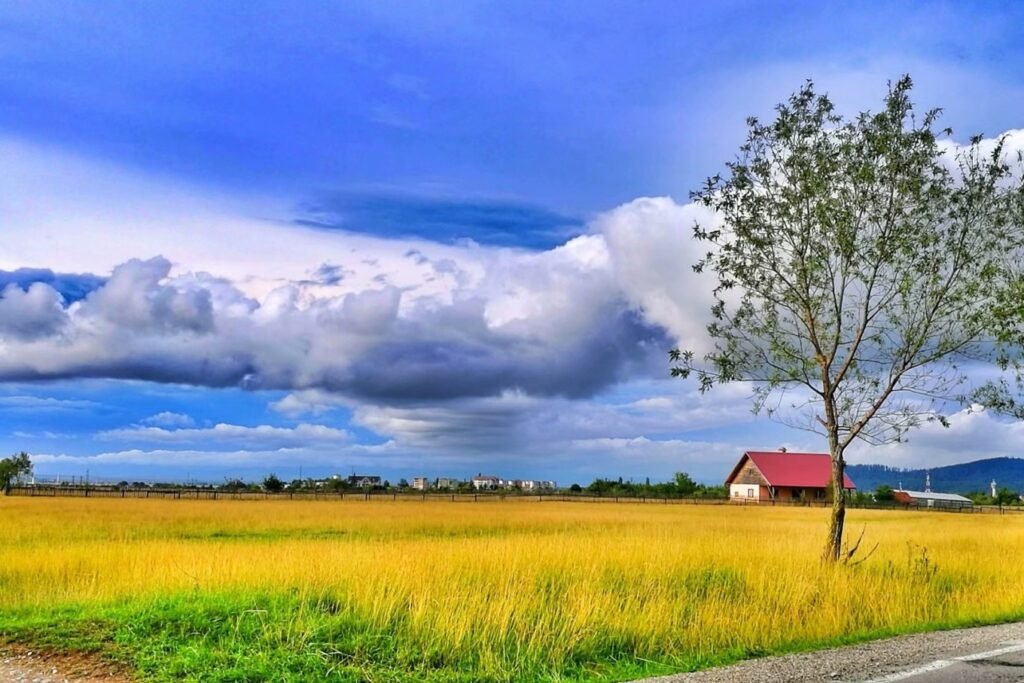
Brașov
Continuing north from Râșnov brings you to Brașov, the heart and largest city of the Transylvania region, and Romania’s second-largest city after the capital, Bucharest. While it sounds like a major metropolis, in reality, Brașov is a quaint old town nestled in a mountain valley. Surrounded by the lush, rolling peaks of the Carpathian Mountains, the old town is confined to a small corner of the valley, with densely packed houses and narrow streets paved with cobblestones or stone bricks. A leisurely walk around the old town takes no more than two hours.
At the center of the old town lies Council Square, a spacious gathering spot surrounded by key landmarks such as the Town Hall and a fountain. As in Râșnov, a large white sign spelling out “BRASOV” stands prominently on the mountaintop, making it a striking sight from a distance.
Thanks to its mountain setting, Brașov exudes a peaceful, tranquil vibe. The streets are quiet, with only a few pedestrians passing by, and cars are a rare sight. This is because Brașov is divided into an old town and a new town—while the bustling new district is located to the north, the old town to the south is a designated tourist area, where fewer people and cars lend an air of calm and relaxation. There are not many shops, but visitors will occasionally encounter a café, ice cream parlor, or inviting open-air restaurant.
What captivates visitors most are the historic buildings. Whether due to the natural landscape, environmental protection efforts, or slow economic development and strict regulations, the old town has preserved its historic appearance remarkably well. The streets are lined with Baroque and Gothic-style buildings typical of European classical architecture. Parts of the medieval city wall still encircle the old town, while the original stream that once served as a moat now runs along the perimeter. Two medieval watchtowers rise on the defensive structures outside the walls, giving the old town a distinctly ancient feel, as if frozen in time. In fact, the preservation of Brașov’s old district rivals that of many other European cities, even comparable to those in Germany.
Brașov’s origins trace back to the early 13th century, making it one of the oldest towns in Romania. It was established in 1211 by German settlers, at a time when Romania as a country did not yet exist. Transylvania was then a contested region, caught between the Germans and the Ottomans. To defend against Ottoman incursions, the Germans, in alliance with the Hungarians, founded seven key towns in the region, including Brașov, Sibiu, and Sighișoara. Over time, as more German immigrants arrived, Brașov grew into the central hub of the area.
Although the city later came under the control of the Habsburg Empire, Hungary, and eventually Romania, it never lost its role as the region’s center. The German culture and traditions that took root in Brașov have become an integral part of the city, enduring through the centuries and shaping its unique character.
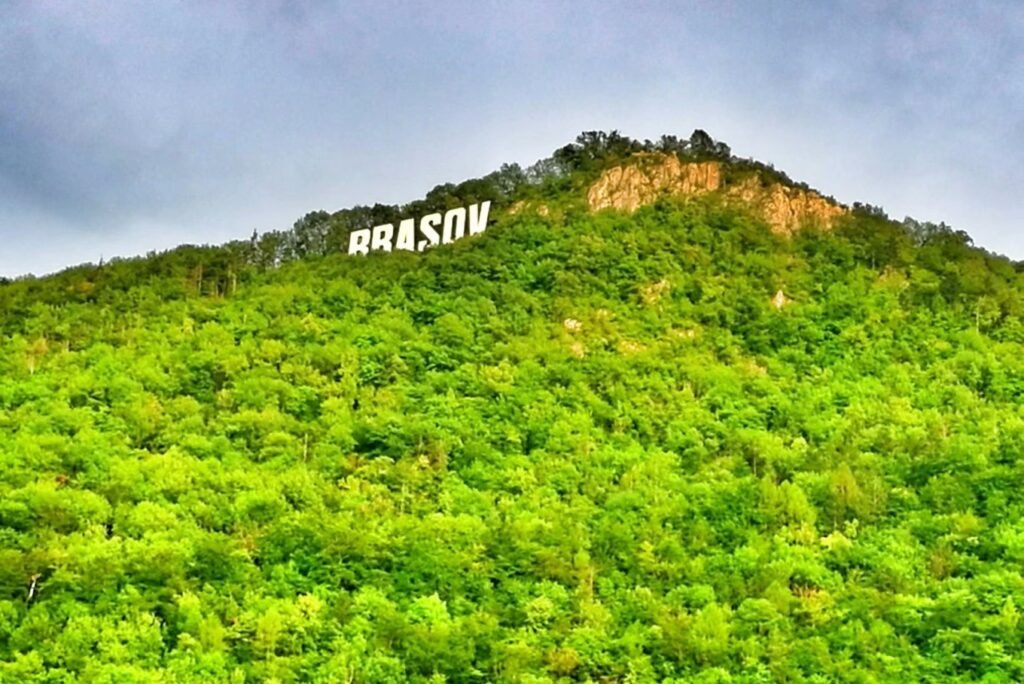
Tampa Mountain rises behind the old town of Brașov, with the large white “BRASOV” letters on its summit, visible from afar. Visitors can take a cable car from the base of the mountain to the top, where they can enjoy panoramic views of the entire old town of Brașov.
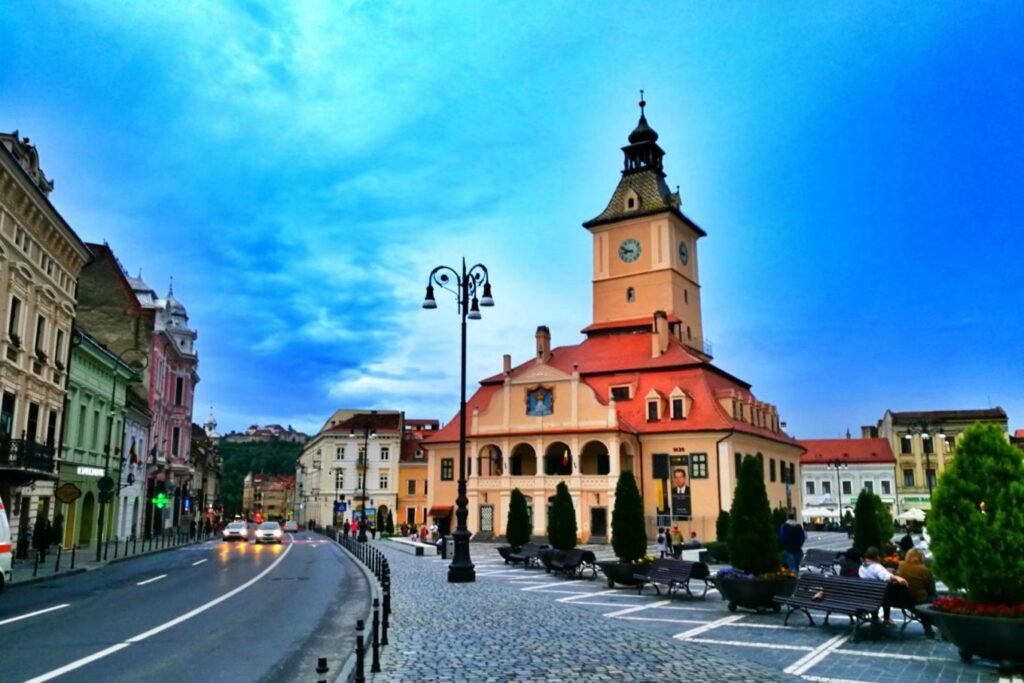
Republicii Street (Strada Republicii)
This main commercial street, called “Republicii Street,” retains the name from Romania’s communist era. During that time, in honor of the Soviet-led socialist community, the town was once proudly renamed “Stalin City.” However, time has erased much of that past—the statue of Stalin was long ago toppled, and the traces of the revolution have faded. Only the medieval architecture endures, preserving the town’s historic charm to this day.
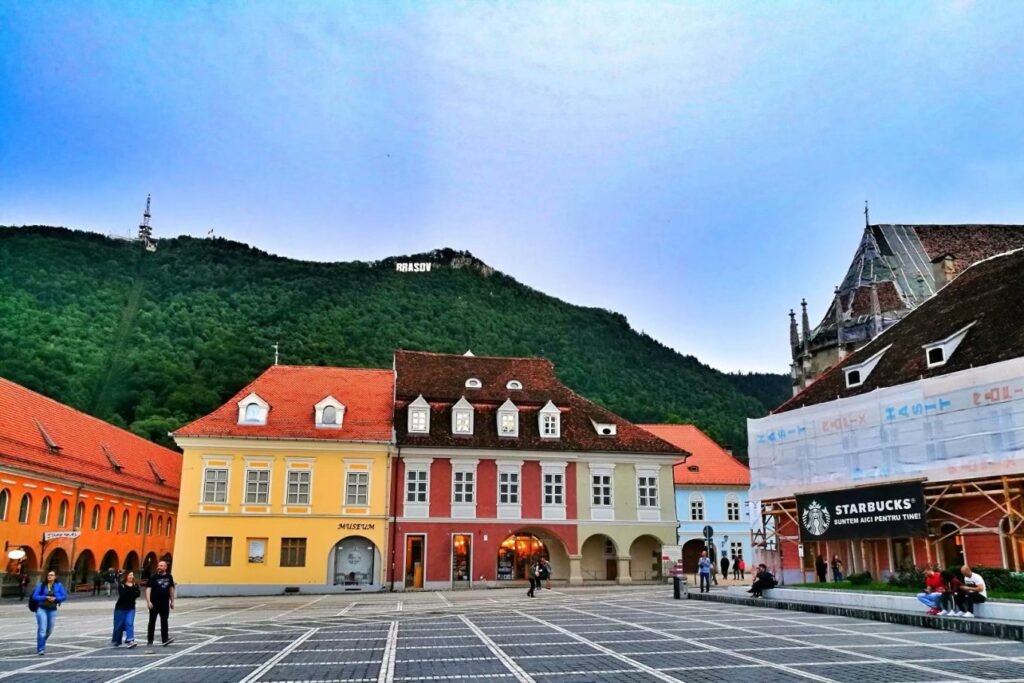
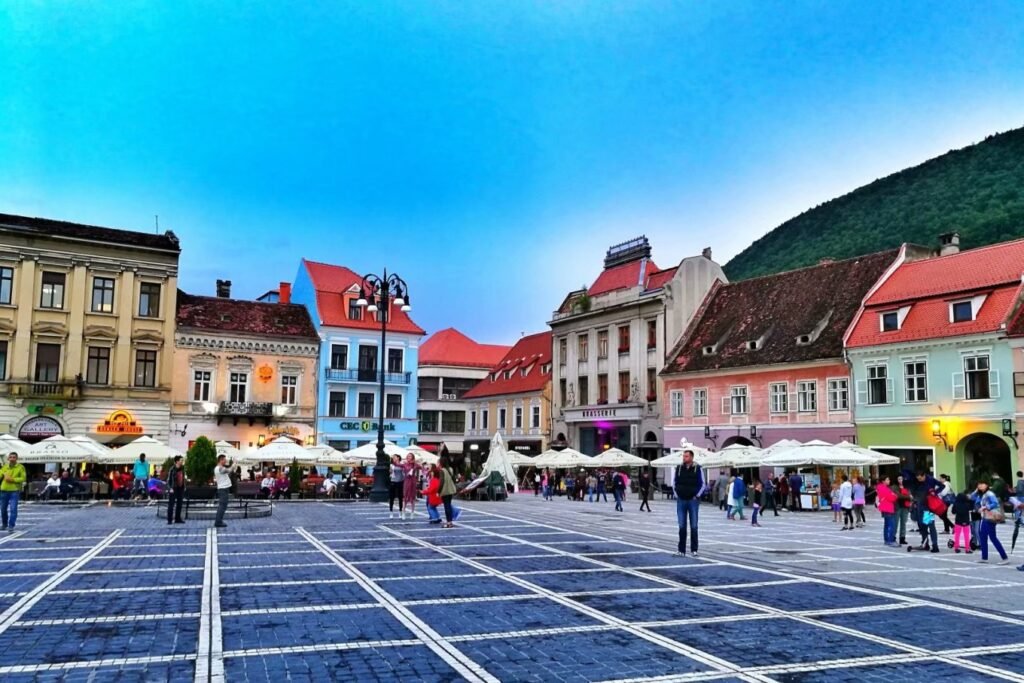
Council Square (Piața Sfatului)
In contrast to the quieter streets, the spacious Council Square, also known as the Main Square (Brașov Main Square), is lively and bustling. Since 1364, it has been the site of major local events and remains the venue for the town’s annual market, attracting merchants and visitors alike.
At dusk, the square fills with tourists and locals out for a stroll. Children play, pigeons take flight, and in the center of the square, a group of young people can even be seen gracefully dancing, adding to the vibrant atmosphere.
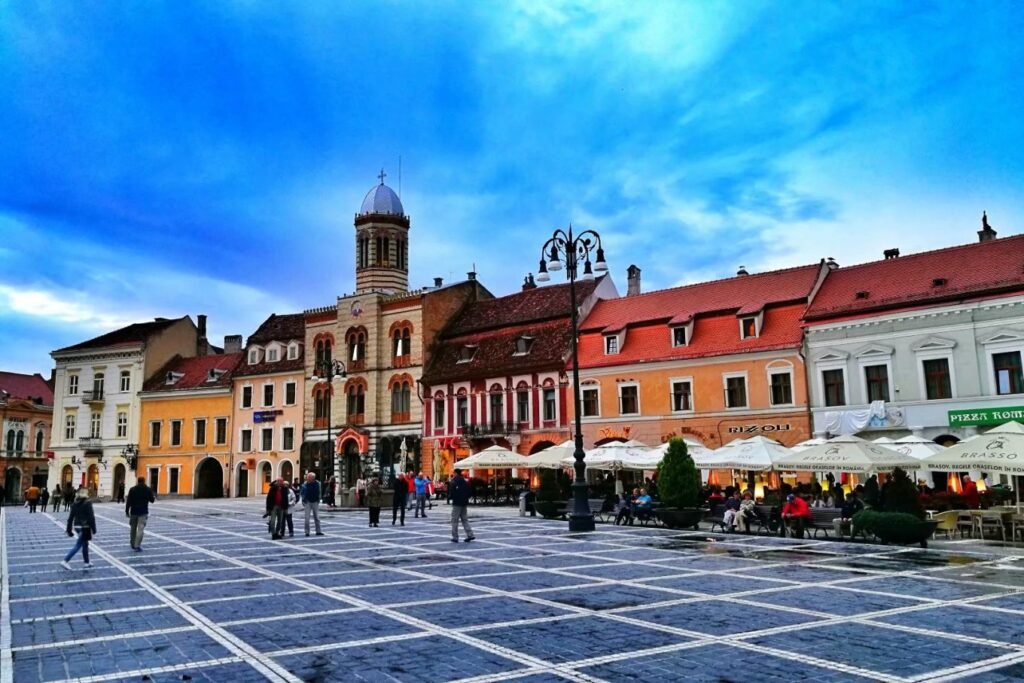
Church of the Dormition of the Mother of God (Biserica Sfânta Adormire a Maicii Domnului)
The Church of the Dormition of the Mother of God is an Eastern Orthodox church in Brașov, located near the Main Square. However, since Romanians practicing Orthodox Christianity were not permitted to build churches in the city center at the time, the church was hidden behind a row of tightly packed houses. Fortunately, its tall bell tower remains visible, making it easier to spot.
Construction of the church began in 1894 and was completed in 1896, funded by donations from over a hundred Orthodox families. The church’s design is inspired by a Greek church in Vienna, and its interior is beautifully decorated.
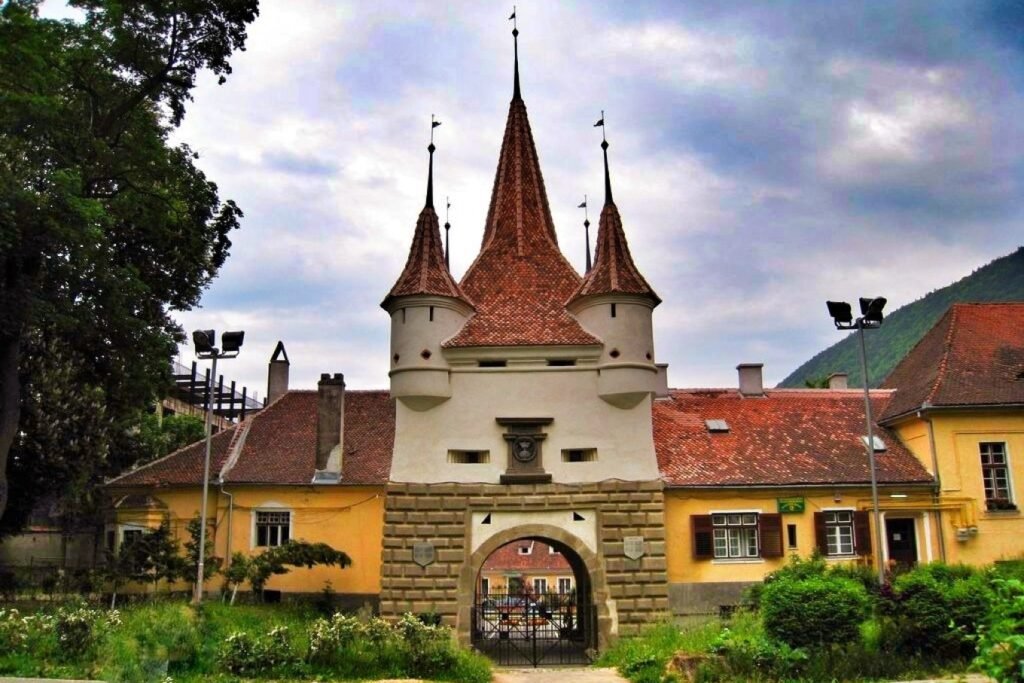
Catherine’s Gate (Poarta Ecaterinei)
Catherine’s Gate is a square-shaped gate built in the Renaissance style, also known as the “Corpus Christi Gate” or the “Upper Gate.” Constructed in 1559, it is a surviving part of Brașov’s old defensive fortifications, which originally featured four such towers. Situated between the Weavers’ Bastion and the Blacksmiths’ Bastion, Catherine’s Gate is the only gate that pierces the western wall of the fortress.
For centuries, it served as the main entrance to the old city of Brașov and remains one of the city’s most important historical landmarks to this day.
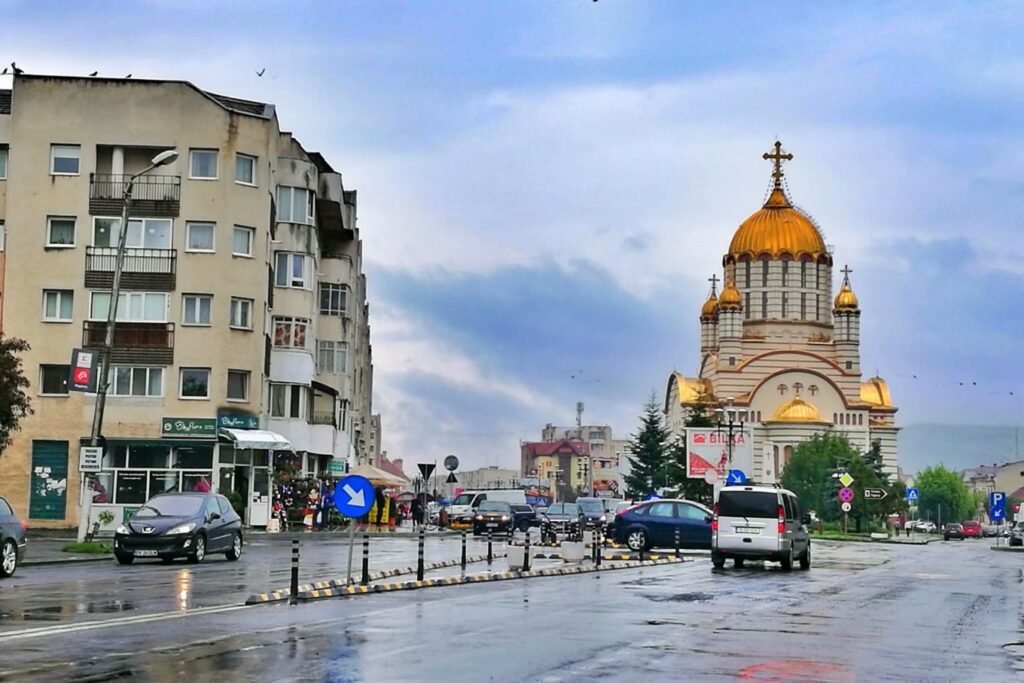
Făgăraș
Driving west from Brașov for about 60 kilometers brings you to Făgăraș, a small town in the Transylvania region of Romania. Nestled along the picturesque banks of the Olt River, Făgăraș remains under the administration of Brașov County. Founded in 1222, around the same time as Brașov, the town covers less than 40 square kilometers and has a population of under 40,000, making it a typical small city.
Like many other towns in the region, Făgăraș is known for its clean streets, numerous churches, and, most notably, a large and well-preserved fortress that adds to its historic charm.
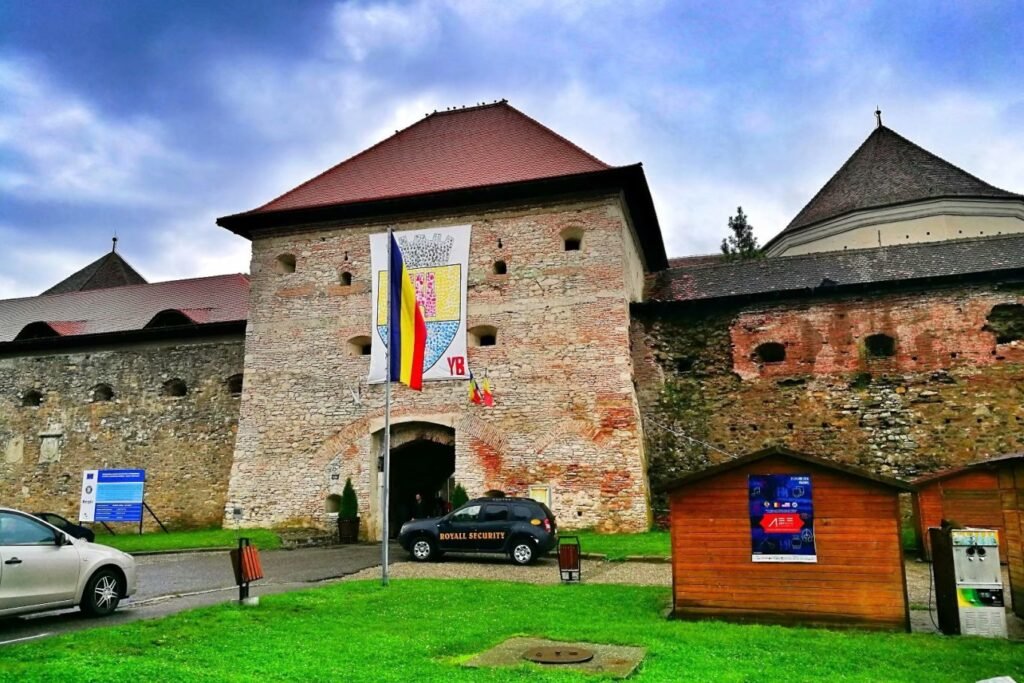
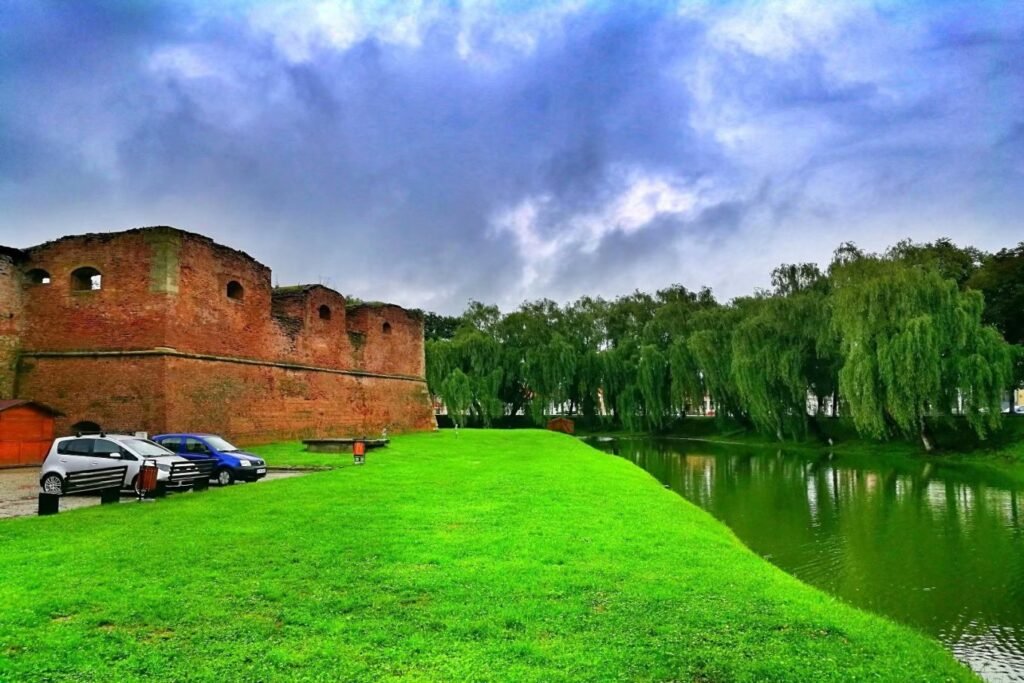
Făgăraș Fortress (Cetatea Făgărașului)
Ticket price: 15 RON
Located in the heart of the city, Făgăraș Fortress is a massive and unique historical structure, regarded as one of the most beautiful medieval fortresses in Romania. It is also one of the few military fortifications in the country that was never conquered by enemies. The fortress seamlessly blends history, culture, architecture, art, and nature, offering visitors a glimpse into the city’s and the castle’s past.
The construction of the fortress began in 1310. In the 16th century, it evolved from a simple military stronghold into a fortified city. During the 17th century, additional defensive structures were built, and the walls were thickened and expanded, resulting in the impressive scale seen today. For centuries, the fortress played a vital role in defending against external threats and consolidating power. During the time of the Principality of Transylvania, it even served as the regional capital for a period.
However, for much of its history, the fortress was used as a tool of control and repression. During the Habsburg era, it was converted into a prison, where political prisoners were held for extended periods. The Romanian Communist regime continued to use it as a political prison.
In 1960, the fortress underwent extensive renovation to restore its original appearance, with efforts made to replicate and restore the original furnishings. It reopened to the public as a historical museum, focusing on the local heritage. Today, it is an exceptional castle-museum, offering visitors a comprehensive tour that takes about an hour. Within the fortress, there is also a distinctive city library, adding to the cultural value of the site.

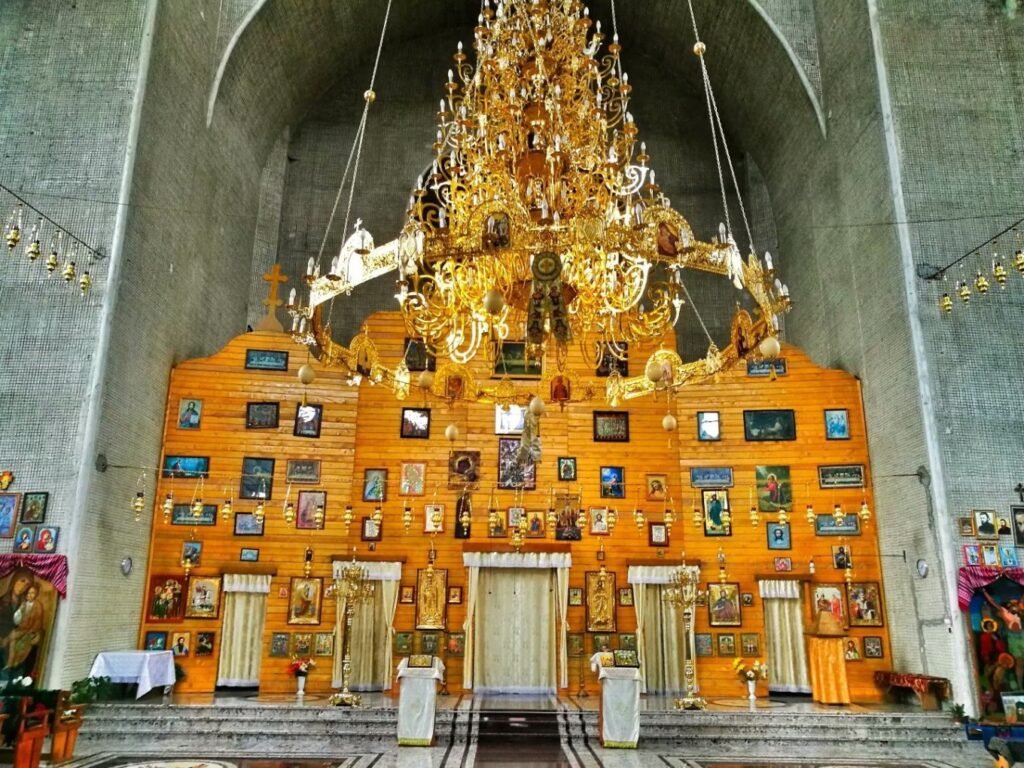
St. John the Baptist Cathedral (Catedrala Sfântul Ioan Botezătorul)
St. John the Baptist Cathedral is the most prominent landmark in Făgăraș, located on the town’s main thoroughfare, not far from Făgăraș Fortress. Its distinctive, towering dome gleams with gold, drawing attention from a great distance.
It is said that the site once housed a modest wooden church, which was completely destroyed by the Ottomans in 1650, forcing the congregation to seek refuge in nearby village churches for worship. After the end of Ottoman rule, the church was rebuilt. The current structure is both grand in size and surrounded by a large expanse of greenery. However, the interior remains somewhat unfinished, with relatively simple wall decorations still awaiting completion.
Sibiu
Sibiu is famously known as the “City of Eyes,” a nickname derived from its unique architectural style. At first glance, the houses in Sibiu look similar to those in other nearby towns, with pointed roofs, thick walls, and bright colors, often featuring red tiles and white facades. However, what sets these houses apart are the rows of small windows on the attic roofs. These trapezoid-shaped windows resemble human eyes, and the larger the roof slope, the more of these windows appear. From a distance, it seems as if countless eyes are watching you, making these “eyed” rooftops a distinctive feature of Sibiu.
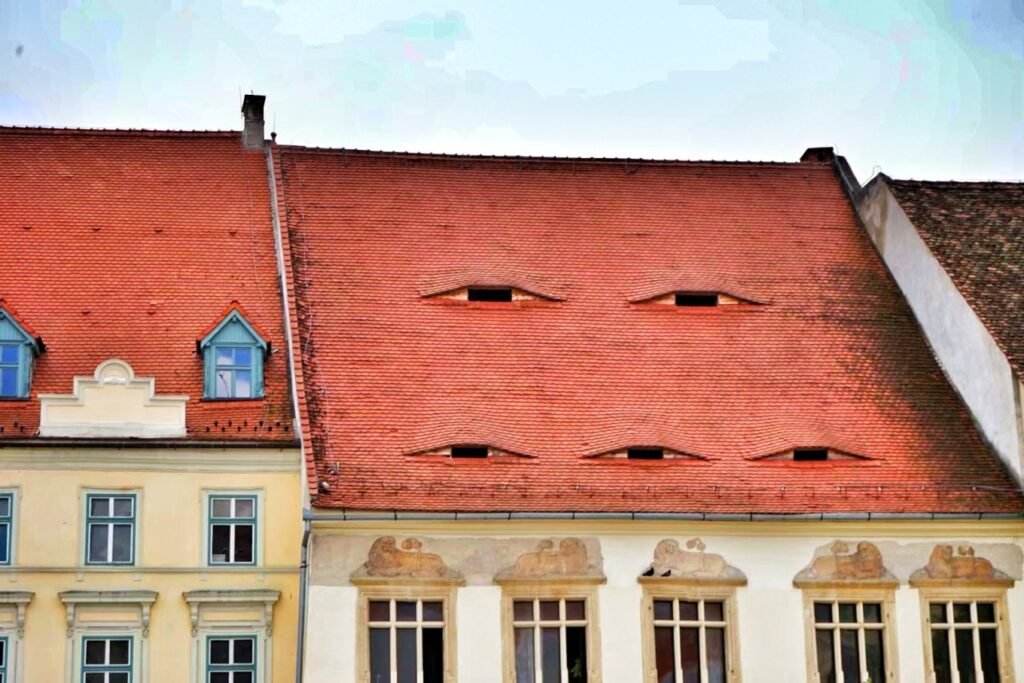
Sibiu is a city with a strong German influence, founded by Germans in the 12th century as one of the seven towns established by Saxons in the Transylvania region. It remains one of the areas in Romania with the highest concentration of German heritage. Both German immigrants and Hungarians significantly contributed to the city’s development. Early on, wealthy Saxon merchants established a thriving craft economy, and during the Middle Ages, the city grew with fortresses, walls, and churches. Many of these Baroque and Gothic-style buildings are still surrounded by thick walls, preserving the old town’s medieval atmosphere.
Starting in the 14th century, Sibiu became a key commercial hub. By the 17th century, it had developed into the center of trade and transportation for the Principality of Transylvania. Under Habsburg rule, the city also became the seat of the Metropolitan Bishop of the Romanian Orthodox Church, further enhancing its importance. The city expanded its external connections and experienced rapid economic growth, reaching new heights of prosperity.
In the 19th century, Sibiu emerged as the economic center of Transylvania and later became part of Romania along with the principality. Throughout German rule, Sibiu remained one of the most prosperous cities in Romania and attracted significant foreign investment—a trend that continues today. Even now, the city’s mayor is of German descent.
Known for its beautiful greenery, Sibiu is nicknamed the “City of Oaks.” Its rich history and cultural heritage earned it the title of European Capital of Culture, designated by the European Union.
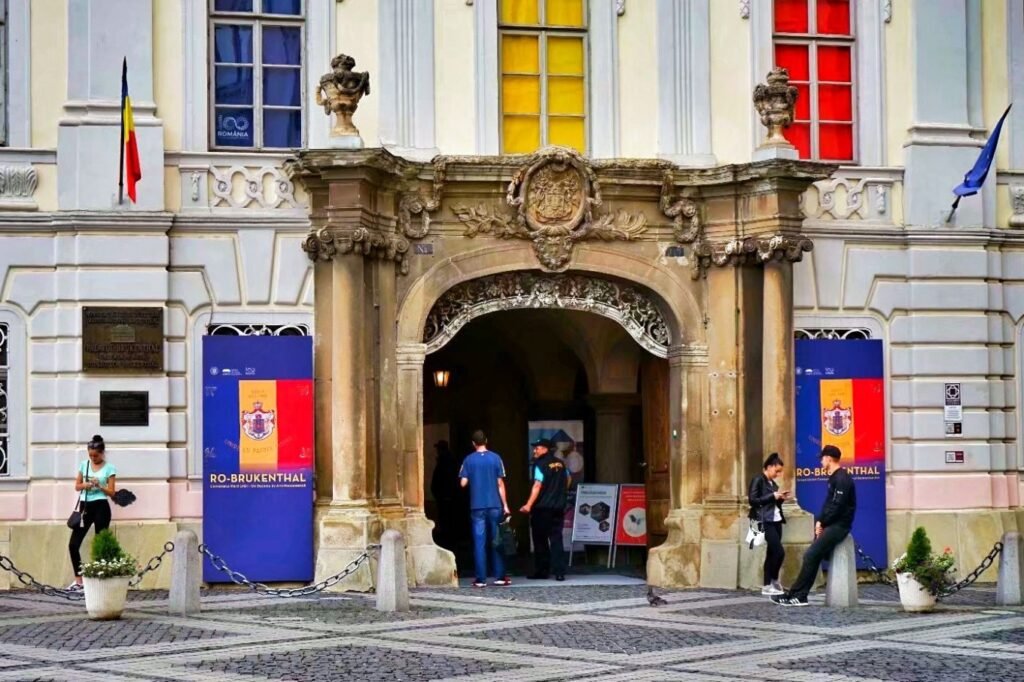
Brukenthal National Museum (Muzeul Național Brukenthal)
The Brukenthal National Museum was founded by Baron Samuel von Brukenthal, the first governor of Transylvania under the Habsburg Empire and a passionate art collector. Between 1778 and 1787, he constructed the palace-like building in Sibiu, which he later transformed into a public museum in 1817. Brukenthal donated many of the artworks he had collected from places like Vienna to the museum.
The Brukenthal Museum is not only one of Romania’s most significant privately established museums but also one of the earliest museums in Europe. In addition to its extensive collection of artworks, the museum complex also includes the Natural History Museum, the Pharmacy Museum, and the Hunting Museum.
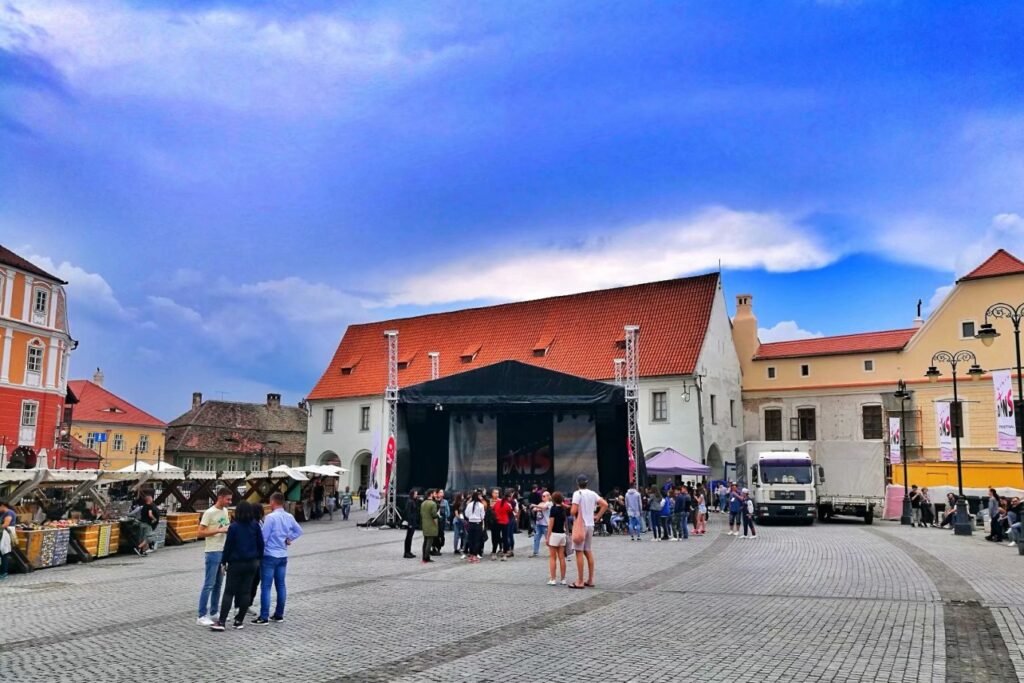
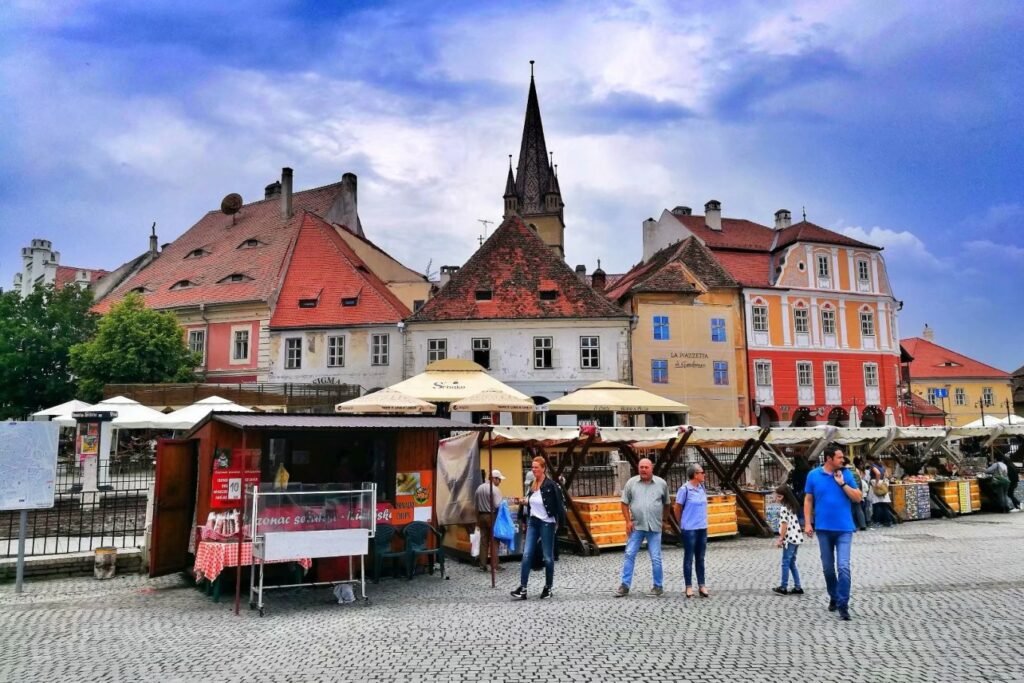
A temporary stage tent has been set up in the square, likely in preparation for a music concert. Along the edges of the square, rows of vendor stalls are clustered together, selling a variety of handicrafts, local specialties, souvenirs, and regional foods. This lively, makeshift marketplace offers a glimpse into the square’s past as a hub for grain trading.
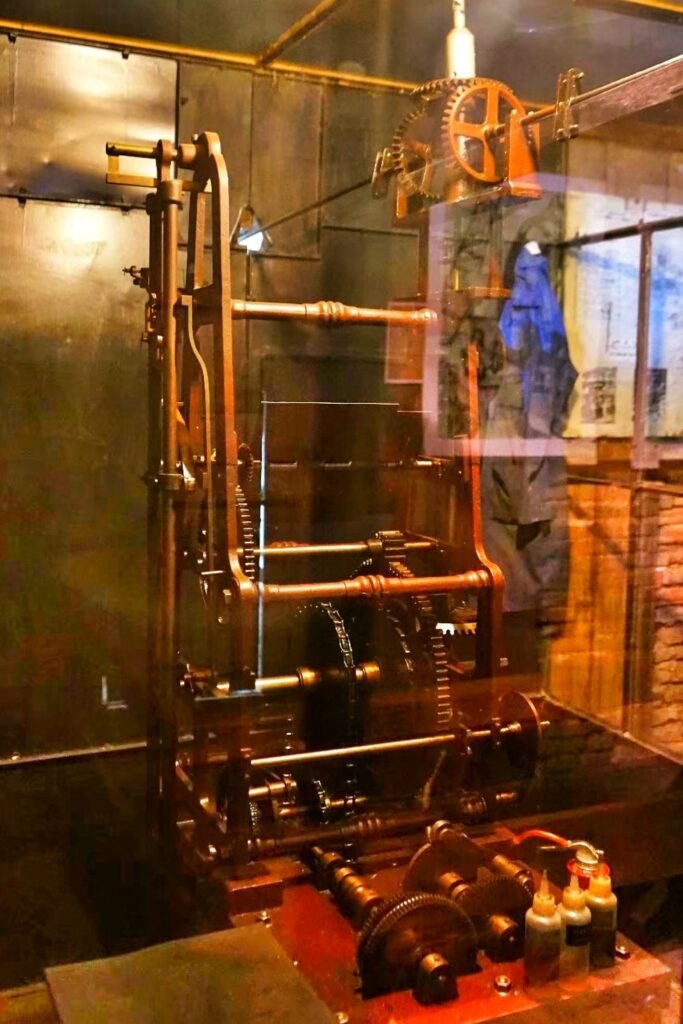
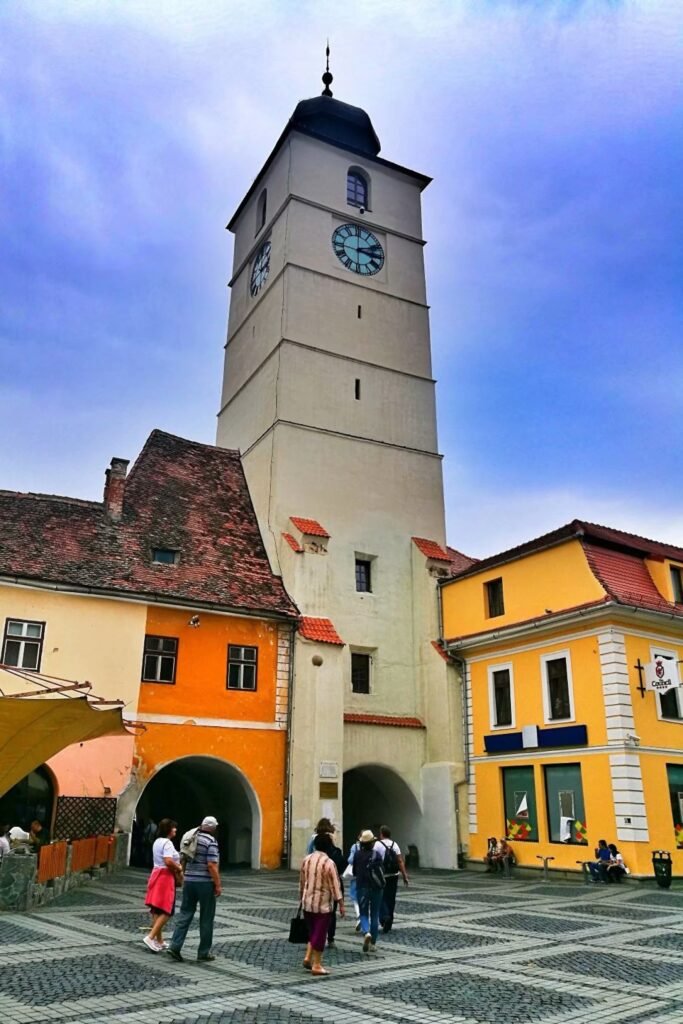
The Council Tower (Turnul Sfatului)
Ticket Price: 2 RON
The Council Tower, also known as the Tower of Advice, stands between the Small Square and the Large Square and serves as a symbol of the city. Originally built in the late 16th century, the tower has collapsed and been rebuilt multiple times throughout its history. In the past, the tower’s gate served as the southern entrance to the fortress, and the observation platform at the top remains the highest vantage point in Sibiu.
Climbing to the top is a bit of a challenge. The staircase is less than a meter wide, with spiral steps and narrow spaces that may induce claustrophobia. However, the effort is well worth it—after ascending more than a hundred steps, visitors are rewarded with breathtaking panoramic views of Sibiu’s old town.
Along the way, visitors can explore exhibitions on each transitional floor, showcasing various displays. At the top level, they will also find the mechanism of Sibiu’s oldest Swiss-made clock, a fascinating piece of the city’s history.
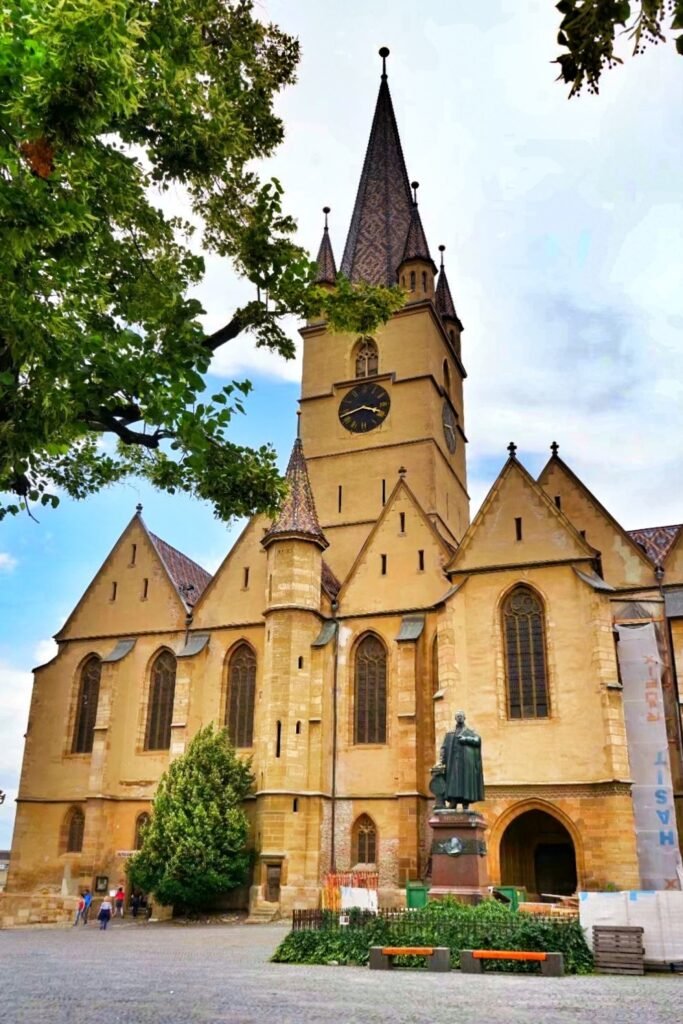
The Evangelical Cathedral C.A. St. Mary (Biserica Evanghelică C.A. Sfânta Maria)
Tower Entrance Fee: 15 RON
St. Mary’s Evangelical Cathedral, belonging to the Lutheran Church, is also known as the Lutheran Cathedral of St. Mary. Located in the Upper Town’s Huet Square, the church has stood for over 600 years. Built in the Gothic architectural style, it houses the largest pipe organ in Romania. Interestingly, the son of Vlad the Impaler, the inspiration for the Dracula legend, is buried here.
The cathedral’s most captivating feature is its spire—the tallest clock tower in the city. From the top, visitors can enjoy panoramic views of the skyline and take in the beauty of the entire town. However, climbing the tower is not for the faint-hearted. With its hollow interior and suspended iron ladders, it can be even more nerve-wracking than the Council Tower. Those with a fear of heights are strongly advised against attempting the climb.
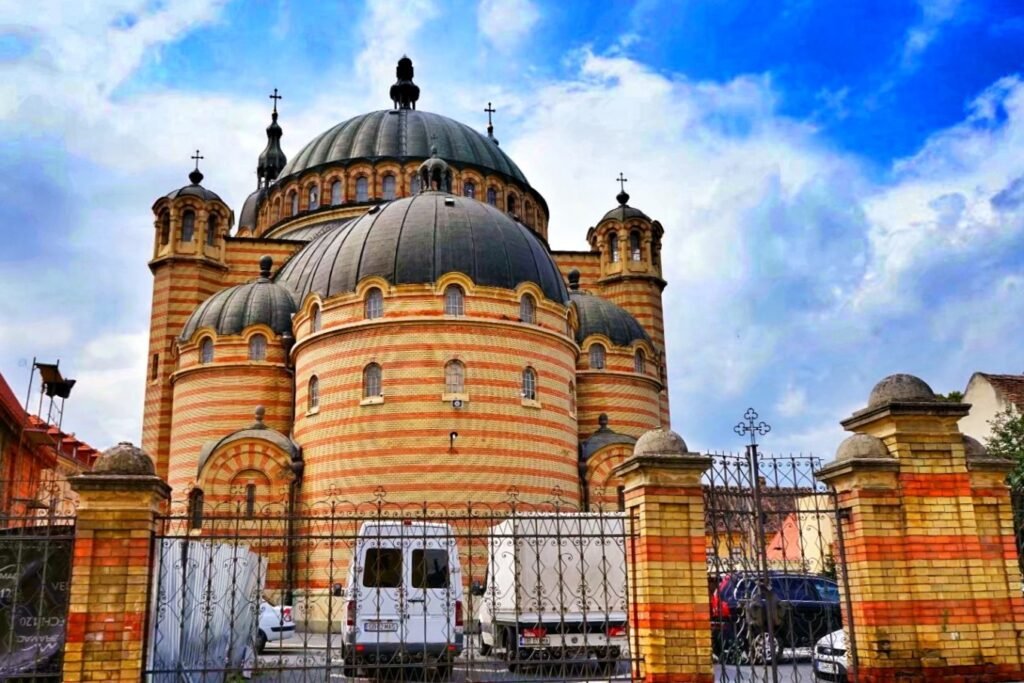
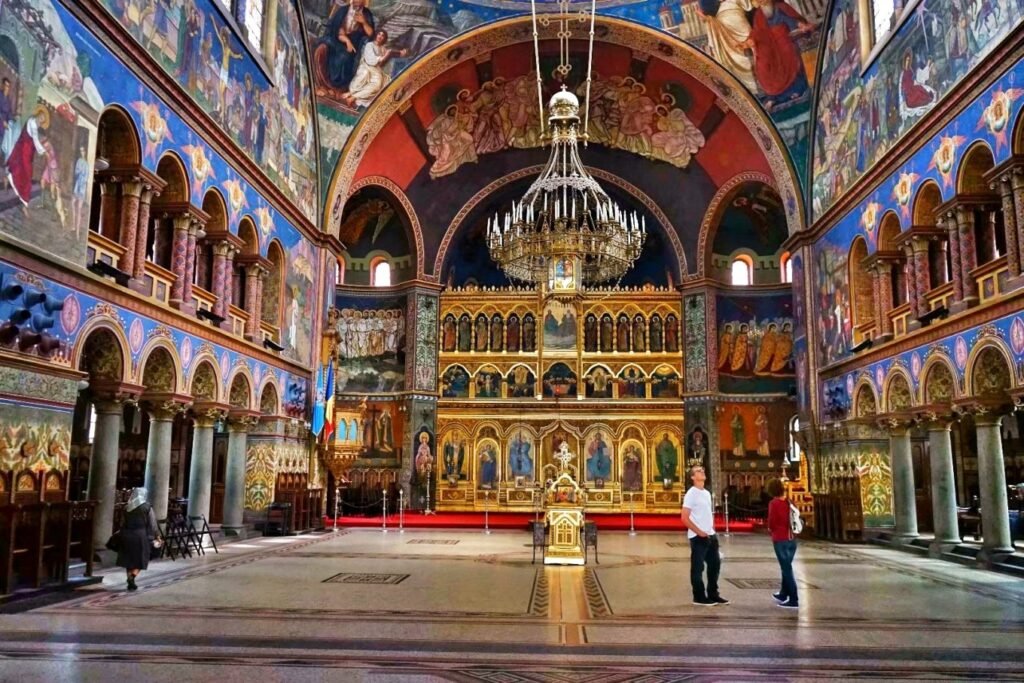
Holy Trinity Cathedral (Catedrala Sfânta Treime)
The Holy Trinity Cathedral is the Orthodox cathedral of Sibiu and the seat of the Metropolitan of Transylvania. Founded in 1864 by Bishop Andrei Șaguna, it is one of the most important religious centers of the Romanian Orthodox Church.
The cathedral is an impressive example of Byzantine architecture, modeled entirely after the Hagia Sophia in Istanbul. Inside, the decorations are lavish, with intricate frescoes covering the entire ceiling and classical artworks adorning every corner. It is considered one of the most magnificent churches in Romania.
Timișoara
Our final stop in Romania is Timișoara, also known as Temesvár. Situated in the westernmost part of the country, Timișoara was once the capital of the Banat region and is now the capital of Timiș County. The city covers around 130 square kilometers and has a population of over 300,000, primarily Romanians, along with Hungarians, Germans, Serbs, Bulgarians, Italians, Greeks, Jews, and Roma, making it a multi-ethnic region. After crossing the rugged Carpathian Mountains, the terrain flattens as you enter Timișoara, with the peaceful Bega River flowing gently through the city. The city’s name derives from the former Timiș River.
Situated at the crossroads of Romania, Hungary, and Serbia, Timișoara has long been a contested area, sought after by various powers. It spent much of its history under the control of the Habsburg Empire and foreign rulers, experiencing political manipulation by Hungary, economic domination by Germans, and cultural influence from Austria, earning it the nickname “Little Vienna.” Its strategic location solidified its political importance, while its multicultural population fostered cultural diversity and development. Despite its remote location, the city has gained a notable reputation and continues to develop steadily.
The city center captivates visitors with its spacious, well-maintained squares, majestic churches, extensive green spaces, and charming old town architecture. Timișoara’s charm easily rivals that of any other European town. Surprisingly, Timișoara was the first European city to use electric streetlights, achieving this milestone as early as 1884.
However, Timișoara is perhaps most famous for the historic events of December 16, 1989, which triggered the nationwide revolution that ultimately brought an end to Nicolae Ceaușescu’s regime. The unrest began with the government’s attempt to deport a Hungarian Reformed pastor, which sparked protests among the Hungarian minority, who had long faced discrimination. Clashes between civilians and police led to casualties, and the incident quickly escalated. Rumors spread that thousands had died, fueling outrage across the nation.
By December 20, massive protests erupted in the capital, demanding a full investigation. The government, caught off guard and mishandling the crisis, soon found itself facing a nationwide uprising. As the situation spiraled out of control, Ceaușescu and his wife fled, only to be captured and executed shortly after, marking the end of communist rule in Romania.
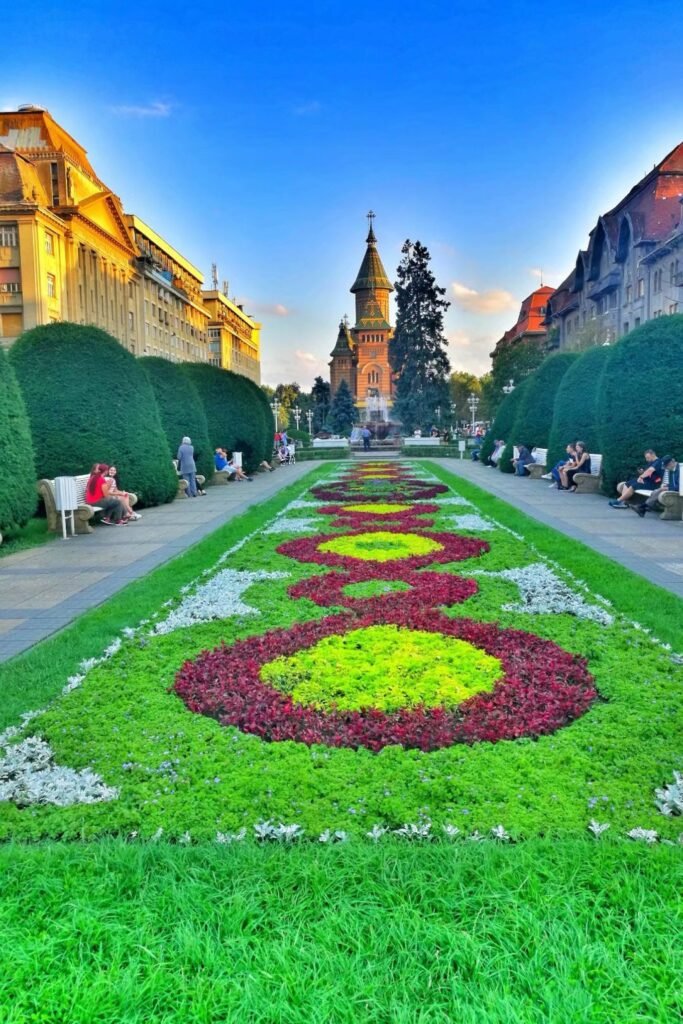
Victoriei Square (Piața Victoriei)
In Timișoara, the most popular destination is undoubtedly Victoriei Square, the symbol of the city. The square is spacious, clean, and well-maintained, surrounded by many iconic and historic buildings. Tall structures line the edges, with green trees providing shade. At the northern end of the square stands the renowned opera house and theater, while the majestic Orthodox Cathedral dominates the southern end.
A series of connected green spaces run through the center of the square, featuring lush lawns, statues of wolves, and decorative fountains. Visitors and locals alike fill the area—some strolling along the paths, others shopping or sightseeing—creating a peaceful and lively atmosphere.
This beautiful square, rich in historical significance yet infused with a sense of leisure and romance, bears no visible traces of the events of 1989 that sparked the nationwide revolution.
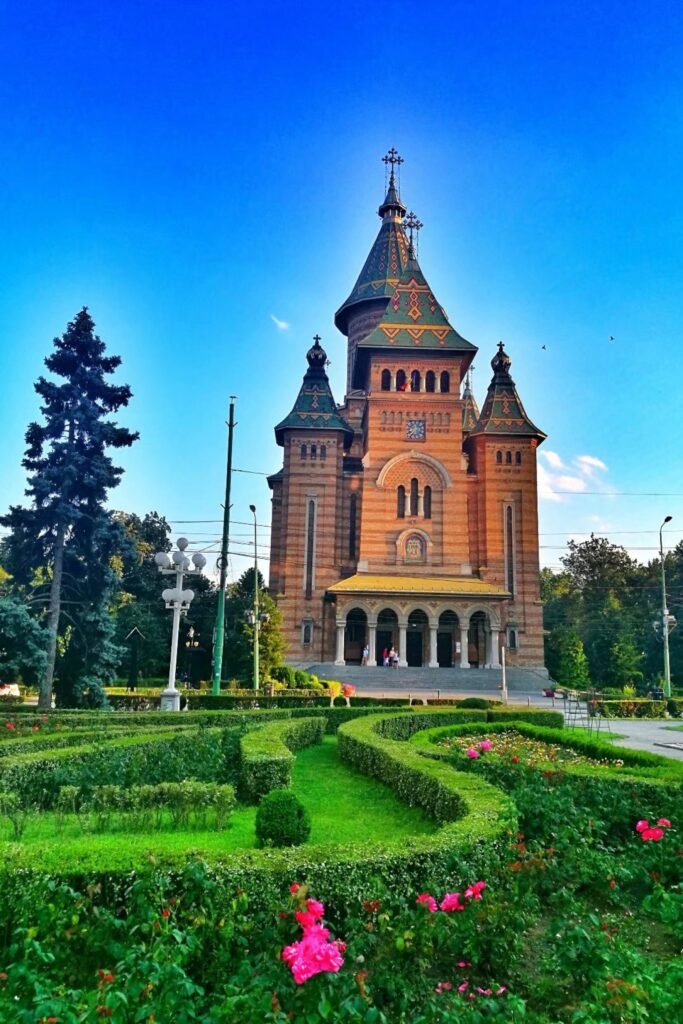
Orthodox Metropolitan Cathedral (Catedrala Mitropolitană Ortodoxă)
The majestic Romanian Orthodox Metropolitan Cathedral is one of the most prominent landmarks in Timișoara. It is often simply referred to as the Orthodox Cathedral. As the city’s largest and tallest building, the cathedral stands out with its striking architecture, combining Russian-style domes with Moldovan church elements. It features 11 towers, with the central tower rising to a height of 96 meters, making it the highest point in the city.
The interior of the cathedral is spacious, capable of accommodating around 4,000 worshippers at once. Despite its grandeur, the church’s history is relatively recent. Construction began between 1937 and 1940 but was delayed due to World War II and completed only in 1946, after the war.
However, the cathedral faced further challenges during the socialist era, as the Romanian Communist regime forced it to close its doors, restricting worshippers’ access. Some accounts claim that many young people sacrificed their lives for the right to practice their faith freely, with some reportedly dying at the church’s entrance. Regardless of the exact details, it was here in 1989 that the events triggering Romania’s revolution and the fall of communism began, marking the cathedral as a symbol of both faith and resistance.
Today, the Orthodox Metropolitan Cathedral has been designated a national historical monument of Romania, bearing witness to the city’s tumultuous history and the struggles endured for freedom and faith.

